Compared to other up-wing flies, the Blue Winged Olive (Serratella Ignita) is a small (5-7mm) fly that can be identified by its blue-grey wings, three stripy tails, large hind legs, and bodies coloured from green-olive to brown-olive.
The Blue Winged Olive is widespread on many UK rivers. In the Northwest, they typically appear from May to August, with the peak hatch occurring around June time.
Importantly, when they appear on the Welsh Dee and River Ribble, brown trout and grayling can become preoccupied with feeding on them and ignoring the larger flies that can be hatching.
Therefore, it’s essential to have flies in your fly box that are good imitations of the blue winged olive, representing the various stages of its life cycle.
“an essential fly to the dry fly fisher when it appears”
Blue-winged Olive Nymph
Blue winged olive nymphs are often found crawling and clinging to moss-covered stones and aquatic vegetation in all types of running water.
In addition, they often drift short distances to identify new feeding grounds. This is when trout and grayling will intercept them.
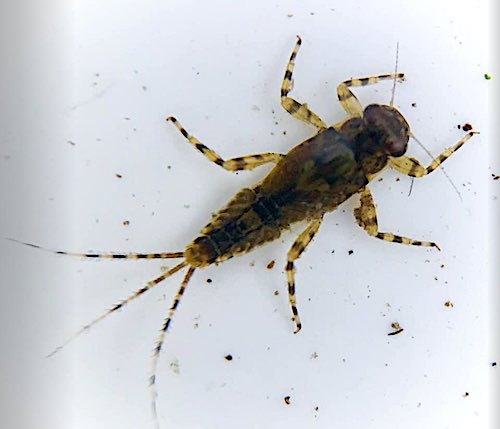
Photo by Adam Fewtrell
The nymphs have several distinguishing features the most visible to the naked eye is their stripy tails and legs (clear and brown banding).
Nymph Patterns:
The pheasant tail, Hare’s Ear and olive nymphs are excellent flies to imitate the blue winged olive nymphs. Tied on sizes 16 & 18 hooks with and without tungsten beads depending on the depth of water being fished:
- gold or copper beads for murky water, and
- uncoloured bead when the water is crystal clear.
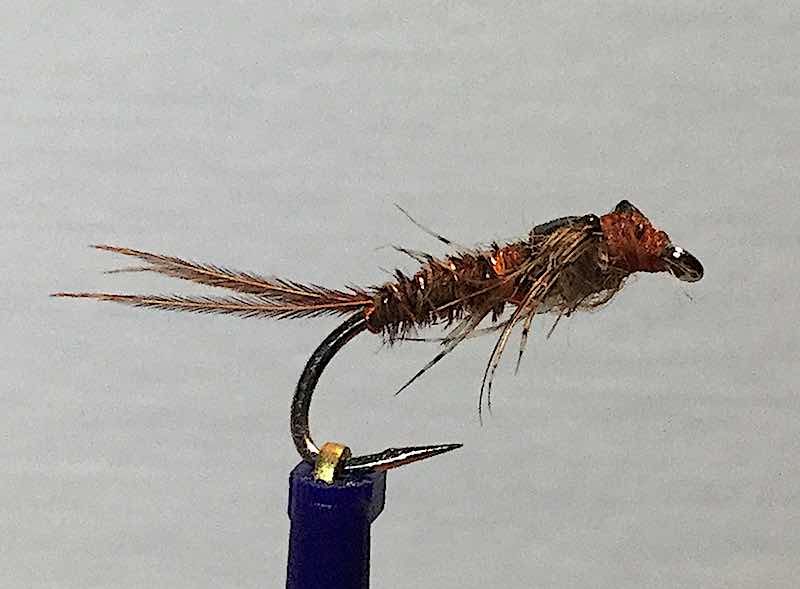
Pheasant Tail nymph
- Kamasan B170 (#16 & #18)
- Orange UNI-thread 8/0
- Tail – 3 pheasant tail fibre tips
- Body – pheasant tail fibres
- Rib – fine copper wire
- Thorax – Hare’s Ear dubbing
- Legs – brown partridge neck tip
- Wing case – natural nymph skin
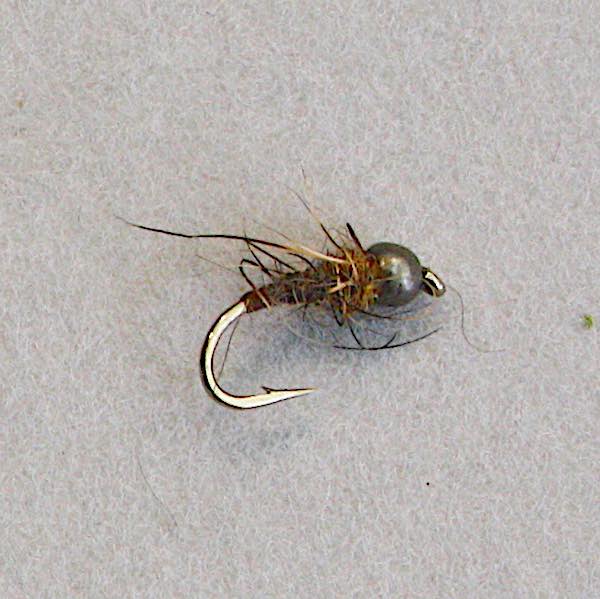
Hare’s Ear Nymph
- Hook: Kamasan B100 (# 16 & 18)
- Bead: 1.5 tungsten (natural, copper or gold)
- Thread: Brown UNI-Thread 8/0
- Body: Hare’s Ear dubbing
.
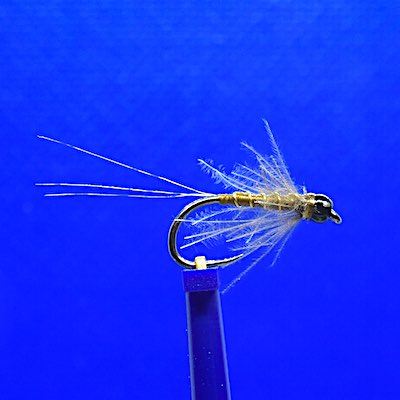
Blue winged Olive nymph
- Hends BL 354 (#16 & 18)
- Bead – black tungsten
- Olive UNI-thread 8/0
- Tail – 3 Coq-de-leon fibres
- Body – olive thread
- Rib – fine gold wire
- Legs – CDC hackle
I find it best to fish these nymphs in pools and glides where there is an abundance of moss-covered stones or weed patches.
Fish the nymphs close to the riverbed; I have the most success fishing them on a French leader (i.e. Euro / Czech nymphing).
To hatch, the nymphs swim out into open water, and at this stage of their life cycle, trout and grayling generally feed on them (i.e. nymph, emerger or dun stage).
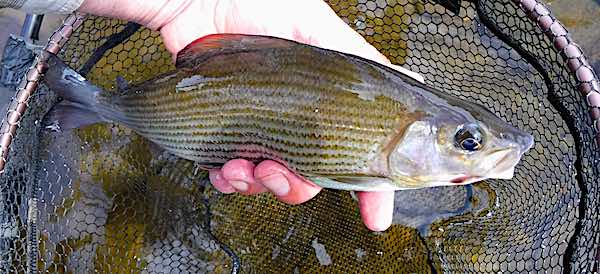
Blue Winged Olive Dun
Duns normally hatch when the day warmers up, from the mid-morning to late afternoon. On the Welsh Dee, peak hatches occur between June and July.
The blue-wing olive is one of the flies that retains its central tail when it hatches from its nymph stage.
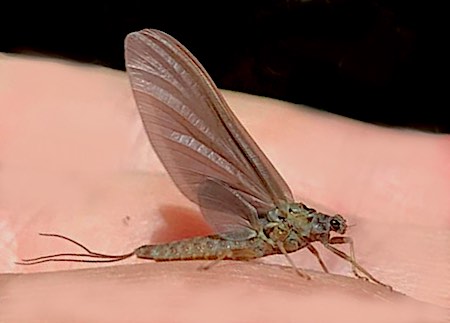
Blue winged Olive Dun
Male and female blue-wing olive duns look similar with blue-grey wings and three grey tails.
Females have dark green eyes and the body is a greenish olive, which turns to a brownish olive as it ages. Whereas, the male has red eyes and body colour that varies between orange-brown and olive-brown.
Fly Patterns for the BWO dun
The Blue winged olive is a small fly compared to the other up-winged flies. Therefore, when matching the hatch, you should select an olive representation of a similar size to the natural flies.
There isn’t a single pattern that will cover all blue-winged olive hatches; therefore, it is important to carry a few fly patterns in your fly box. The three patterns I find cover most situations are as follows.
Greenwell’s Glory Dry Fly
In streamy water, a general olive imitation is usually acceptable. My favourite is a size 16 Greenwell’s Glory tied with a parachute wing. In rough water, you might have to go up one size (#14) and maybe use a version with an orange post, which makes it easier to see.
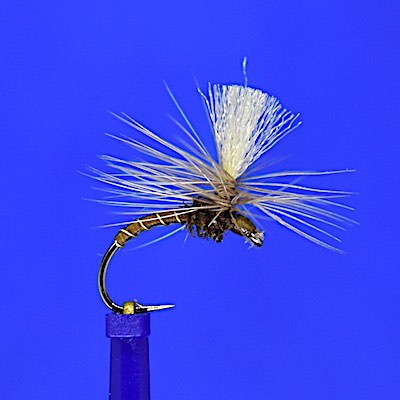
Greenwell’s Glory
- Hook: Kamasan B100 (# 16 & 18)
- Body: Brown-Olive UNI-Thread 8/0
- Rib: Fine gold wire
- Thorax: Peacock Herl
- Wing post: cream Antron Yarn
- Hackle: Medium Dun
.
CDC Olive Emerger
Sometimes, trout and grayling are selective in taking the emerging dun, especially in the slower sections of the pools. When faced with this scenario I have found that the following CDC olive pattern is rarely refused.
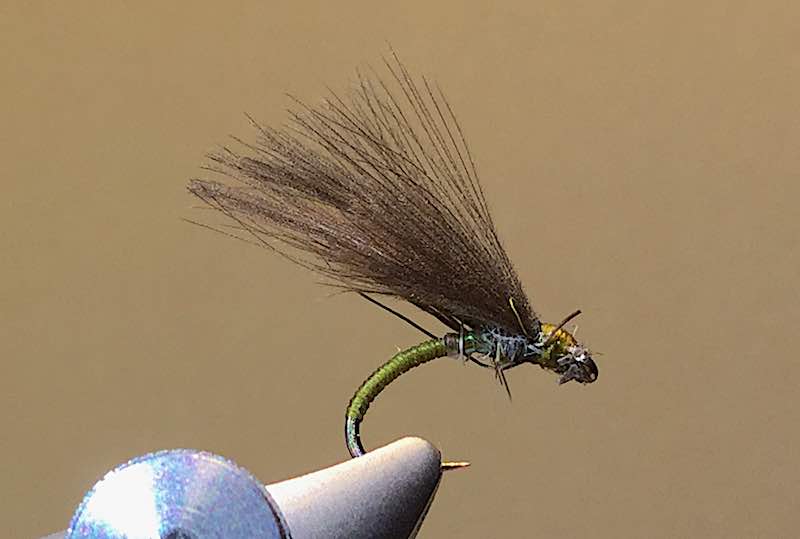
CDC Olive Emerger
- Hook: Kamasan B100 #14
- Thread: Olive UNI 8/0
- Body: Hare’s Ear dubbing
- Underwing: 4 Elk hair fibres
- Overwing: 3 CDC feathers
The CDC wing allows the body to sit in the surface film.
It is a good idea to have a few tied with different coloured bodies, e.g. brown olive, dark green olive, and light green olive. Then if your first choice is ignored, switching to a different coloured one will often result in success.
Parachute Blue Winged Olive:
Another pattern worth tying is a parachute BWO with a range of body colours from brown to light olive. This is a good pattern for fishing in poor light conditions because you can use different coloured posts to aid visibility
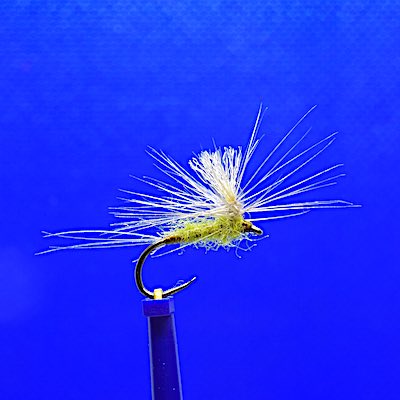
Blue Winged Olive – Parachute
- Hends BL 354 (#16 & 18)
- Olive UNI-thread 8/0
- Tail – iron blue cock
- Body – olive SLF dubbing
- Wing post – Cream Antron yarn
- Hackle – iron blue cock
If the above choices fail, I will resort to fishing this wet fly pattern just under the surface.
.
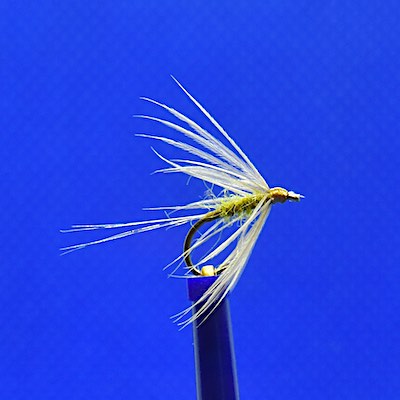
Blue winged olive wet fly
- Hends BL 354 (#16 & 18)
- Olive UNI-thread 8/0
- Tail – iron blue cock
- Body – olive SLF dubbing
- Hackle – iron blue hen
.
Blue Winged Olive Spinner
After mating, the female Blue-Winged Olive spinner returns to the river to lay its eggs.
At this stage in its lifecycle, it becomes an important fly to trout, grayling, and hence the angler.
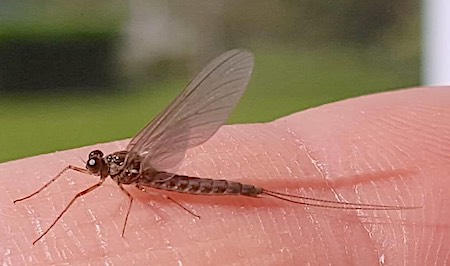
Photo taken by Reg Woods
On maturing into a spinner, its wings turn transparent and its body turns orange-brown, similar to the colour of a medium sherry. Hence anglers have named it the Sherry Spinner.
When the female spinners are about to lay their eggs in the evening, they begin hovering near the tail of the pool or the riffle just above the next pool. The spinner will then dip onto the surface of the water to lay its eggs.
Trout will take up positions at the head of the pool to feed on exhausted spinners trapped and dying in the surface film. Often the best trout will be lying directly below any foam lines.
On the Welsh Dee, grayling will often position themselves in the “V” of the tail of the pool and take the spinners as they are laying their eggs.
On mid-summer evenings, fishing a dry Sherry spinner where spinners are laying their eggs will produce some…
quality trout and grayling.
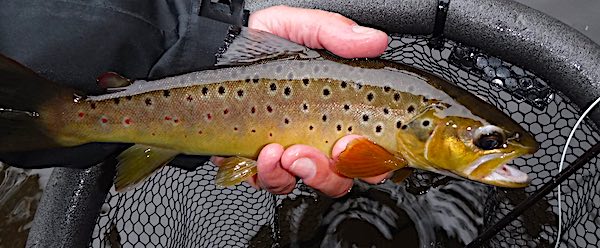
I prefer spinner imitations that are simple to tie and have splayed wings at right angles to the body. The splayed wings allow the fly to sit in the surface film, which perfectly imitates the spent insect and fools those wary trout.
The following fly pattern has had a prime spot in my fly box for many years because it has proven itself as a pattern that consistently catches trout and grayling during a BWO spinner fall.
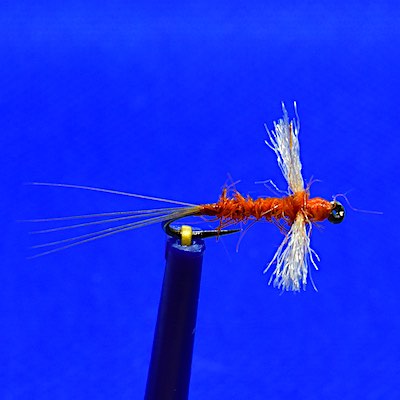
Sherry Spinner
- Hends BL 354 (#16 & 18)
- Orange UNI-thread 8/0
- Tail – brown cock
- Body – orange dubbing
- Wing – Cream Antron yarn
Spinner fishing tips:
The evening rise to a fall of blue winged olives spinners is usually short, ca. an hour or so at best. Therefore, it’s best to have a plan on where and how you are going to spend this…
Magic Hour.
It’s best to decide in advance which pool(s) you will fish. Select a pool that:
- is likely to have a good head of trout and/or grayling
- has a smooth, steady flow
- is easy to access without spooking the fish
On the Welsh Dee at Llangollen, a selection of pools that meet the above criteria and hence are worth fishing includes Fridge Pool, Pipe Pool, Hollybush Pool, etc.
Usually, the light will be fading while you are fishing, therefore make sure you know your way around the pool (where it is safe to wade). Don’t forget to have a head touch with you.
All of the BWO fly patterns discussed above catch fish on most UK rivers and definitely on the Welsh Dee at Llangollen, where I spend most of my time fishing. For more on fishing the Welsh Dee check out my digital fly fishing guides.
There is some excellent day ticket water on the Welsh Dee, where you could try out these blue wing olive fly patterns.
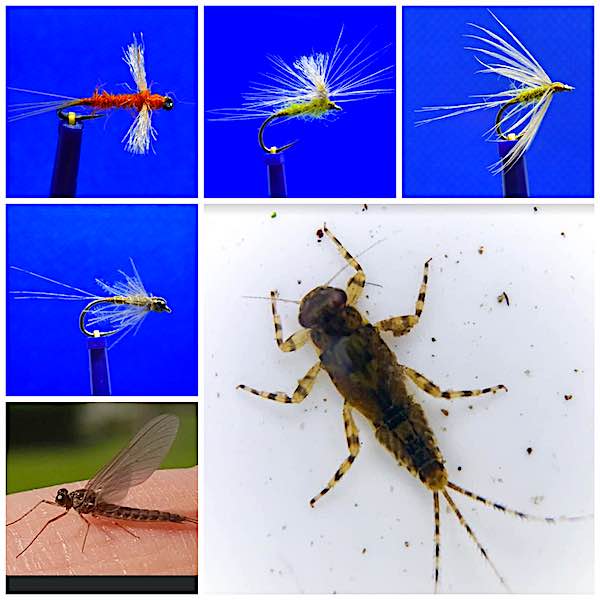
Excellent article as always. I spent yesterday evening on tha PAAS water above Erbistock on the Welsh Dee. As I arrived there was a hatch of large mayfles Danica I think. Some of which were being aggressively intercepted by heavy trout ( silver ? Sea trout) ,but most not. I couldn’t get close. There were plenty of rises to other smaller flies. I switched to an olive DHE pattern on a size 16 and started to get good sport with some nice grayling. Magic. I’m guessing your article may have enlightened me as to why. Thankyou!
Hi Peter,
I’ve never caught a trout fishing a Dancia mayfly pattern on the Welsh Dee the fish just seem to ignore large flies. However, put a small dry fly on and it’s a different story. Good to hear you spotted a sea trout at Erbistock.
Great to hear you enjoyed the post and thanks for the feedback.
Cheers, Andrew
Great information Andrew love the witching hour.
Great to hear you enjoyed the post.
An important fly here in Ireland too. I find an orange seals fur body with grizzle cock hackle and tails can work well.
Hi Colin,
Thanks for the fly tip. I will tie a few up and give them a go on the Welsh Dee.
Cheers, Andrew
Great article and I also like the way things are explained. I’d also like to mention a couple more patterns that I find to be successful:
– tup’s indispensable – a pale coloured dry fly that is especially good during hatches
– starling and herl wet fly – useful for imitation of emerging BWOs and some caddis flys (especially with a caddis green hotspot on the back of it)
– orange quill – kinda like the sherry spinner but can be taken for a sedge (and IIRC according to authorities like Skues taken at night for the BWO)
Ohhh and one more thing to consider is that I’ve only seen the parachute pattern being dressed the same way but without the hackle. Am going to try out the variation being mentioned here. 😀
Thanks again for the article!
Hi Ivan,
Great to hear you enjoyed the post and thanks for the recommendation on other flies to try.
Cheers, Andrew
Excellent piece Andrew Thank you.
Cheers
Great article Andrew, Great patterns for BWO.
Great to hear you enjoyed it.
Cheers, Andrew
I love fishing bluewing olives here in Northern Ireland it one of my favorite flys and hatches.
Hi William,
Do you have a favourite BWO pattern you like to fish?
Tight lines, Andrew
not really Andrew i fish a lot of patterns mostly all quilled-bodied.
A great site Andrew always full of interesting ideas and flies. Looking forward to tying and using your blue winged olive examples. Keith
Hi Keith,
Great to hear you are enjoying it. Also, would be good to know how the BWO patterns perform.
Tight lines, Andrew
Another good blog Andrew, I particularly like the green wells dry fly.
Hi Peter,
It is a great fly that has served me well over the years.
Tight lines, Andrew